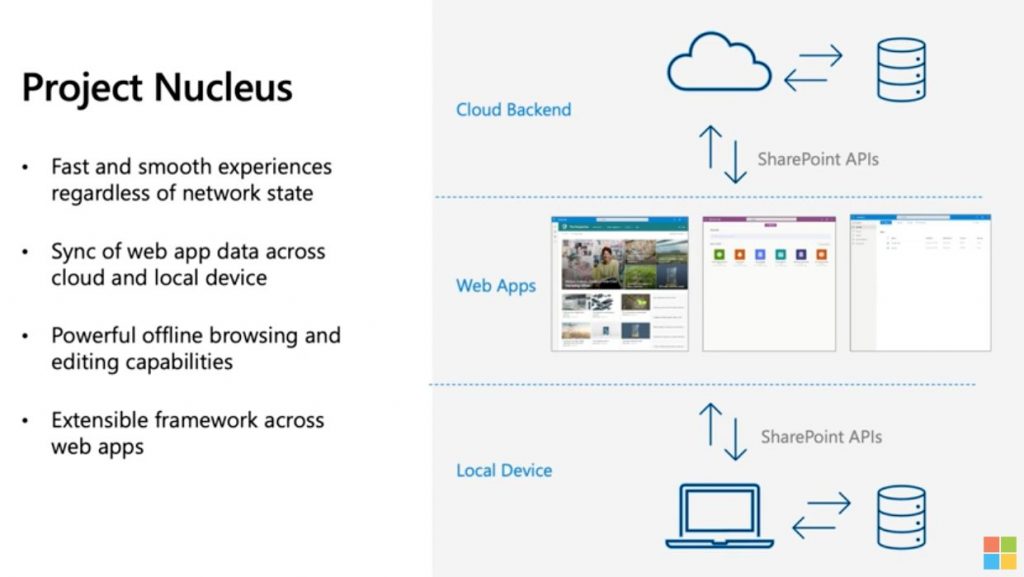Microsoft Ignite Virtual 2020: SharePoint Project Nucleus
As the virtual SharePoint Ignite conference continues, Microsoft announced another amazing improvement for SharePoint which is sure to bring even more wow factor, efficiency, and speed of use to the platform. As progressive web applications evolve, larger amounts of content affect the speed of performance, impacting the reliability and stability of the app.
Addressing this is Project Nucleus which optimizes web apps and database technologies with intelligent sync. Syncing to a database, intelligent sync will improve speed and performance by keeping a local cache on the client that Microsoft progressive web apps use. With changes synced to a local cache, Project Nucleus enables offline work, and once reconnected the internet, the work is automatically uploaded and synced.
Even though Project Nucleus is initially coming to Microsoft Lists, Microsoft has plans to add these capabilities to Microsoft 365, SharePoint web apps, Microsoft Teams, OneDrive, and possibly other SharePoint portals.
How does it work?
As mentioned, Project Nucleus will keep a local cache on the client that Microsoft web apps use. By bringing together web apps and databases, Project Nucleus ensures that data, regardless of the size of data stored by a web app or internet speed, is always available. Because there are no synchronous round trips when scrolling, sorting, grouping, or filtering the data, throttling will be eliminated, especially when working with large lists. The local cache will increase the performance speed of the apps, provide stability, and ultimately, result in reliability.
The uniqueness of Project Nucleus is that it is not strictly caching the data. Microsoft has leveraged the underlying technology in OneDrive sync so that syncing changes occur at the local cache level (perhaps by implementing SQL Lite for lightweight processing and data caching).
While synching occurs at the local cache level, working offline is easy, simple, and smooth. Once reconnected to an internet source, Project Nucleus automatically syncs the data with intelligent sync so that all changes stored on the local cache are uploaded, updating the information in the cloud.

What, How, and Where I Can Expect to See and Use Project Nucleus?
As always, Microsoft’s enhancements and new products have several focuses, but one common focus is friendly end-user usability. Project Nucleus was developed to help end-users to continue working with large amounts of data and content without decreasing performance speed, regardless of their speed of internet connection.
Debuting with Microsoft Lists, Project Nucleus allows users to work both online and offline with large lists that contain a high amount of content and data. Users will be able to perform common tasks such as filtering, sorting (like columns), and grouping. Like magic, once connected to the internet, all data will be synced, including changes to List Views and Column sorting.
Project Nucleus is a new and exciting direction that is driving the bar higher for online and offline processing of progressive web applications. The ability to store and sync large amounts of data to a database cache on a local client provides Microsoft web apps to perform at lightning speeds when offline.
Amazingly, while working offline, the cached database continually syncs at the local level with the changes that a user performs. Leveraging intelligent sync, Project Nucleus automatically syncs the local cache to the cloud once the end-user is connected to the internet, capturing all changes that an end-user has performed while offline.
It is easy to see how Project Nucleus, as the name implies, will become the centre and the foundation for future development supporting progressive web apps. This is heralding an extremely exciting future with progressive web apps!
 Tuesday, October 13, 2020
By : Mike Maadarani
Tuesday, October 13, 2020
By : Mike Maadarani
 0 comment
0 comment
Archives
- December 2024
- November 2023
- October 2023
- September 2023
- August 2023
- January 2023
- November 2022
- October 2022
- May 2022
- March 2022
- January 2022
- December 2021
- November 2021
- October 2021
- March 2021
- October 2020
- September 2020
- July 2020
- March 2020
- February 2020
- January 2020
- December 2019
- November 2019
- October 2019
- September 2019
- June 2019
- May 2019
- March 2019
- February 2019
- January 2019
- December 2018
- November 2018
- October 2018
- September 2018
- August 2018
- July 2018
- June 2018
- May 2018
- April 2018
- March 2018
- February 2018
- January 2018
- December 2017
- November 2017
- October 2017
- August 2017
- July 2017
- June 2017
- May 2017
- March 2017
- February 2017
- January 2017
- October 2016
- September 2016
- August 2016
- July 2016
- June 2016
- May 2016
- March 2016
- February 2016
- January 2016
- September 2015
- August 2015
- July 2015
- June 2015
- April 2015
- February 2015
- January 2015
- November 2014
- October 2014
- September 2014
- November 2013
- July 2013
- February 2013